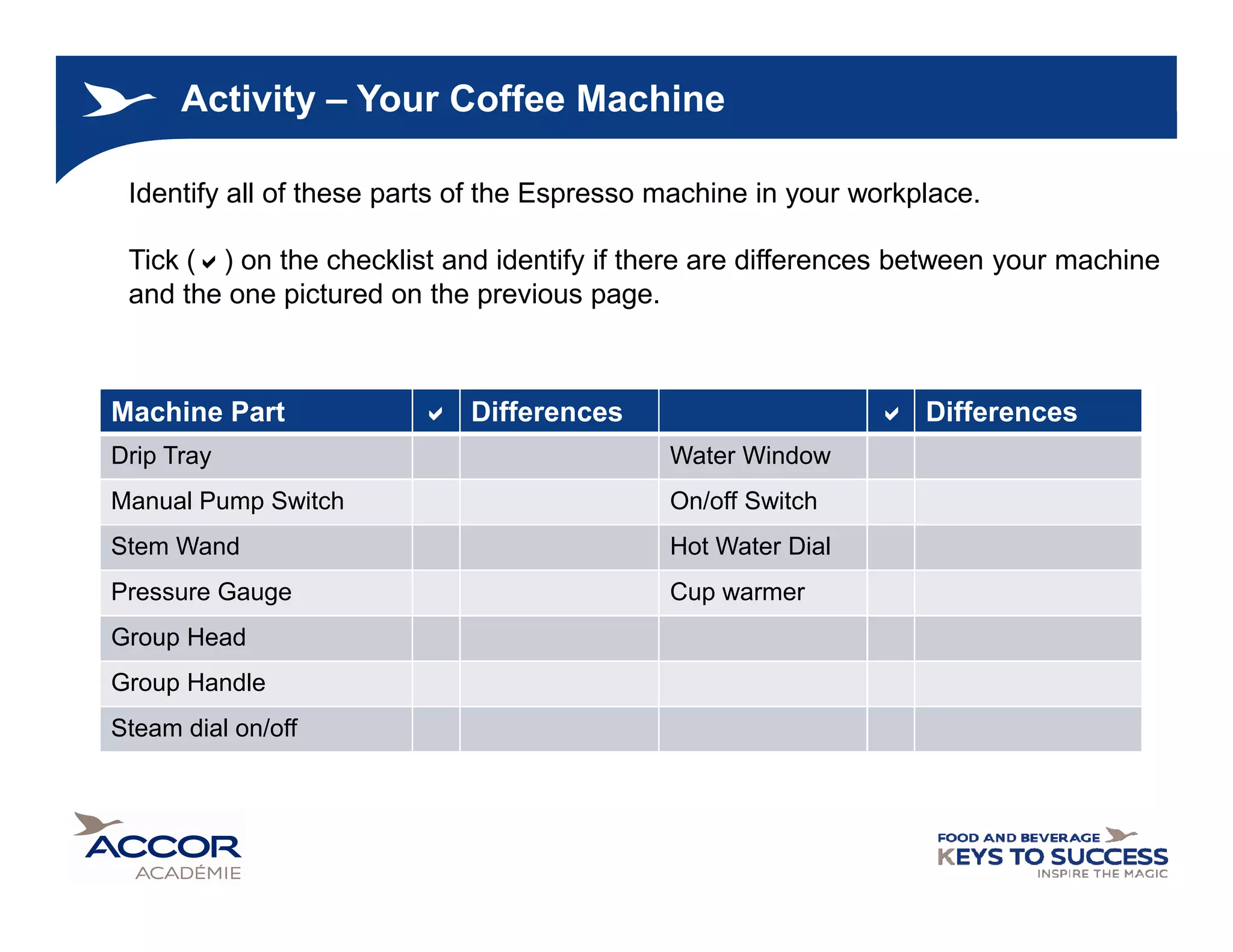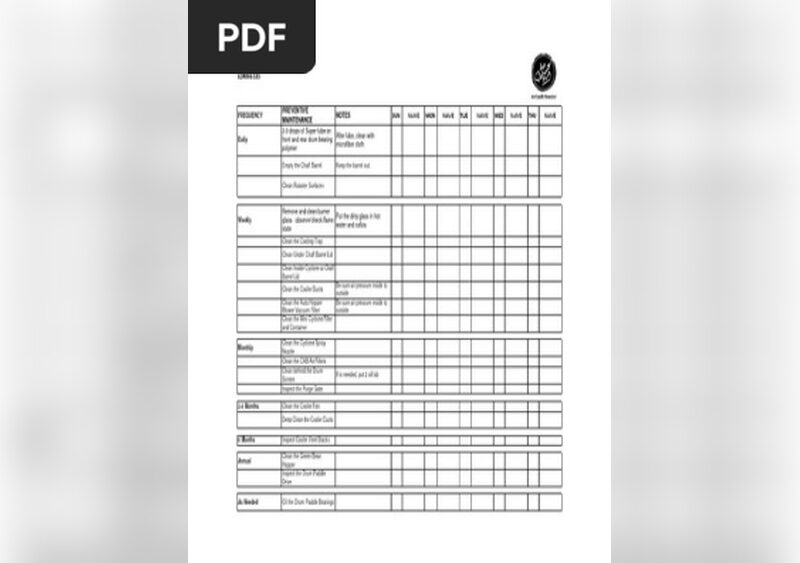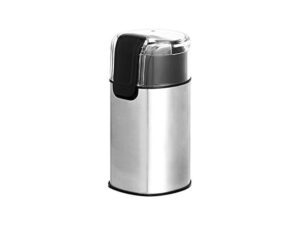Your espresso machine is more than just a kitchen gadget—it’s the key to your perfect cup of coffee every morning. But without regular care, even the best machines can lose their magic.
Imagine biting into your favorite espresso only to find it tastes bitter or weak. Frustrating, right? That’s why having a simple, step-by-step maintenance checklist is essential. You’ll discover easy ways to keep your espresso machine running smoothly and brewing delicious coffee day after day.
Ready to unlock the secret to a flawless espresso? Let’s dive in.

Credit: manuals.plus
Daily Cleaning Steps
Keeping an espresso machine clean is very important for good coffee. Daily cleaning helps the machine work well and last longer. It also keeps the coffee tasting fresh. Simple daily steps can stop dirt and old coffee from building up. These steps protect the machine’s parts and make sure every cup tastes great. Following a checklist makes cleaning easier and faster.
Wipe Group Heads
The group heads are where coffee comes out of the machine. They get dirty fast. Wiping them each day stops old coffee and oils from building up. Use a clean, damp cloth to wipe the group heads carefully. This removes leftover coffee grounds and stops blockages.
Steps to wipe group heads:
-
Turn off the machine’s brewing function.
-
Use a damp cloth to wipe around the group head.
-
Clean the edges and the area where the portafilter locks in.
-
Check for leftover coffee grounds and remove them.
-
Repeat wiping if needed, until the group head looks clean.
Cleaning the group heads daily keeps the coffee flavor pure. It also stops damage to the machine’s parts.
Purge Steam Wand
The steam wand is used to froth milk but can get clogged with milk residue. Purging the steam wand every day clears old milk inside. This prevents bad smells and keeps the wand working well.
How to purge the steam wand:
-
Turn on the steam for a few seconds to push out milk.
-
Use a clean, damp cloth to wipe the outside of the wand.
-
Check the tip of the wand for milk build-up and clean it.
-
Repeat steam and wipe until no milk comes out.
Daily purging stops milk from drying inside the wand. This keeps the steam flow strong and safe to use.
Empty Drip Tray
The drip tray collects water and coffee drips during use. If it is full, it can overflow and make a mess. Emptying the drip tray every day keeps the area clean and dry.
Steps to empty the drip tray:
-
Slide out the drip tray from under the machine.
-
Pour out any water or coffee collected.
-
Wash the tray with warm, soapy water.
-
Dry the tray completely before putting it back.
-
Check for any coffee grounds stuck inside and clean them.
Emptying the drip tray helps avoid bad smells and keeps the machine area tidy. It also stops water damage to surfaces.
Clean Portafilter And Basket
The portafilter holds coffee grounds during brewing. The basket fits inside the portafilter. Both must be cleaned daily to remove old coffee oils and grounds. This helps the coffee taste fresh and stops clogging.
Steps to clean portafilter and basket:
-
Remove the basket from the portafilter.
-
Rinse both with warm water to remove coffee bits.
-
Use a brush or cloth to scrub away oils and stains.
-
Soak in warm, soapy water if needed, then rinse well.
-
Dry both parts before using again.
Regular cleaning of these parts keeps the espresso machine working well. It also helps make every cup taste its best.
Weekly Maintenance Tasks
Keeping an espresso machine clean and well cared for helps it work better. Weekly maintenance tasks stop problems and keep coffee tasting fresh. Simple steps done every week make the machine last longer. These tasks are important for anyone who uses an espresso machine often.
Backflush The Machine
Backflushing cleans the inside of the espresso machine’s group head. This stops coffee oils and residue from building up. A clean group head helps make better-tasting espresso.
Follow these steps to backflush:
-
Insert a blind filter basket into the portafilter.
-
Add a small amount of espresso machine cleaner.
-
Lock the portafilter into the group head.
-
Run the brew cycle for 10 seconds, then stop for 10 seconds.
-
Repeat this process 5 times.
-
Remove the portafilter and rinse it well.
-
Run water through the group head to rinse out cleaner.
Backflushing removes oils that can make coffee taste bitter. Doing this weekly keeps the machine in good condition.
Soak Portafilter And Baskets
The portafilter and baskets collect coffee oils and grounds. Soaking them removes these stuck particles and keeps the parts clean.
Steps to soak portafilter and baskets:
-
Remove the portafilter and baskets from the machine.
-
Fill a container with warm water and espresso machine cleaner.
-
Place the portafilter and baskets in the solution.
-
Let them soak for 15 to 30 minutes.
-
Use a soft brush to scrub off any remaining residue.
-
Rinse all parts thoroughly with clean water.
-
Dry parts completely before using again.
Regular soaking helps prevent clogging and keeps espresso taste pure. Clean parts also last longer and work better.
Clean Shower Screens
Shower screens spread water evenly over coffee grounds. They can get blocked by coffee oils and particles.
To clean shower screens:
-
Remove the shower screen from the group head.
-
Soak it in a cleaner solution for 15 minutes.
-
Scrub gently with a soft brush to remove buildup.
-
Rinse well with fresh water.
-
Dry and replace the shower screen securely.
Dirty shower screens affect water flow and coffee flavor. Cleaning them every week keeps espresso smooth and balanced.
Inspect Gaskets And Seals
Gaskets and seals keep water from leaking during brewing. They wear out with use and need checking often.
Inspection tips:
-
Look for cracks, tears, or hard spots in gaskets.
-
Check seals for any signs of damage or wear.
-
Replace any parts that look worn or damaged.
-
Make sure new gaskets fit tightly and evenly.
-
Regular checks prevent leaks and help machine work well.
Good gaskets and seals keep pressure steady and avoid water leaks. This protects the machine and improves coffee quality.
Monthly Care Routine
Keeping an espresso machine clean and well-maintained is important. A monthly care routine helps the machine work well and last longer. Regular checks and cleaning make sure every cup tastes great. Small tasks done each month keep the machine safe and efficient.
Descale The Machine
Descaling removes hard water deposits inside the machine. These deposits can block water flow and damage the parts. Use a descaling solution made for espresso machines. Follow the instructions on the product carefully to avoid damage.
Steps to descale:
-
Turn off and unplug the machine.
-
Empty the water tank and fill it with the descaling solution.
-
Run the machine to let the solution flow through the system.
-
Let the solution sit inside for 15-20 minutes.
-
Flush the machine with clean water several times to remove all solution.
Descaling keeps the heating element working well and stops bad taste. It also prevents machine breakdowns and costly repairs.
Lubricate Moving Parts
Machines have parts that move and rub together. Lubrication keeps these parts working smoothly. It stops parts from wearing out too fast. Use food-safe lubricant made for espresso machines only.
Parts to lubricate monthly:
-
Group head gasket
-
Portafilter locking mechanism
-
Steam wand joints
Apply a small amount of lubricant to these parts. Avoid over-lubricating as this can cause build-up. Clean the parts before applying lubricant to remove old grease and dirt. This simple step helps avoid machine jams and leaks.
Check Water Filters
Water filters keep hard minerals and dirt out of the machine. Clean water helps the machine last longer and keeps coffee tasting fresh. Check the filter every month and replace if needed.
Signs to replace filters:
-
Water flow slows down
-
Filter looks dirty or clogged
-
Machine shows error related to water
Different machines use different filters. Check the user manual for the correct filter type and replacement steps. Regular filter changes help avoid mineral build-up and machine damage.
Examine Pressure And Temperature
Pressure and temperature affect coffee taste and machine safety. Check these monthly to keep the machine working well. Use a pressure gauge and thermometer if the machine does not have built-in monitors.
Ideal settings for espresso machines:
|
Parameter |
Ideal Range |
Why It Matters |
|---|---|---|
|
Pressure |
9 bars (around 130 psi) |
Ensures good coffee extraction |
|
Temperature |
90-96°C (194-205°F) |
Prevents burnt or sour taste |
Adjust settings if they are outside the ideal range. Too low pressure or temperature causes weak coffee. Too high can damage the machine or burn coffee. Regular checks keep the machine safe and the coffee delicious.
Troubleshooting Tips
Espresso machines need regular care to work well. Problems can stop the machine from making good coffee. Troubleshooting helps find and fix these problems. This checklist covers common issues and simple fixes. Following it keeps the machine in good shape and coffee tasting great.
Fixing Low Pressure
Low pressure in an espresso machine causes weak coffee. It happens when water flow is blocked or weak. Check these points to fix low pressure:
-
Clean the filter and portafilter: Coffee oils and grounds can clog them.
-
Check the pump: It should make a steady noise. If silent, it may be broken.
-
Inspect the pressure gauge: It shows the pressure level. Low reading means a problem.
-
Descale the machine: Mineral buildup can block pipes and reduce pressure.
-
Check for leaks: Water leaks lower pressure inside the machine.
Regular cleaning and descaling keep pressure steady. A simple test is to run water without coffee. If water flow is slow, check pipes and pump.
Addressing Leaks
Leaks waste water and can damage the machine. Find the leak location first. Common leak spots include:
-
Group head seal
-
Water tank connection
-
Steam wand
-
Drip tray
Follow these steps to fix leaks:
-
Replace worn seals: Rubber seals wear out and cause leaks.
-
Tighten loose parts: Screws and joints may loosen over time.
-
Check water tank: Make sure it fits tightly and has no cracks.
-
Clean steam wand: Blockages can cause pressure build-up and leaks.
Use a dry cloth to spot leaks during operation. Fix leaks early to avoid bigger damage.
Resolving Temperature Issues
Correct temperature is key for good espresso. Too hot or too cold water affects flavor. Temperature problems often come from:
-
Faulty thermostat
-
Heating element issues
-
Blocked temperature sensors
How to handle temperature problems:
-
Test the thermostat: Use a thermometer to check water temperature.
-
Clean or replace heating elements: Scale can cover and reduce heating power.
-
Check sensors: Make sure sensors are clean and connected.
-
Let the machine warm up: Some machines need time to reach the right temperature.
Maintaining clean parts and regular checks prevent temperature problems.
Handling Grinder Problems
The grinder affects coffee taste and espresso quality. Common grinder issues include:
-
Inconsistent grind size
-
Jammed burrs
-
Motor problems
-
Excessive noise
Fix these problems by:
-
Cleaning burrs regularly: Coffee oils and dust build up fast.
-
Adjusting grind settings: Make sure grind size fits espresso brewing.
-
Removing jams: Turn off machine and clear stuck beans gently.
-
Checking motor function: Listen for unusual sounds or weak power.
Regular cleaning and proper use keep the grinder working well for fresh coffee.
Tools And Supplies Needed
Maintaining an espresso machine keeps it working well and makes coffee taste great. Tools and supplies are needed to clean and fix the machine. Having the right items helps you care for your espresso maker easily. This checklist shows the tools needed for good maintenance.
Cleaning Brushes
Cleaning brushes remove coffee grounds and dirt from the machine parts. Brushes come in different sizes and shapes. Using the right brush helps clean small and hard-to-reach areas. A soft bristle brush is good for delicate parts. A stiff brush can clean stubborn stains and grime.
Here are common types of cleaning brushes:
-
Portafilter brush: Cleans the basket and spout.
-
Group head brush: Removes coffee residue from the group head.
-
Steam wand brush: Cleans inside the steam wand.
-
Small detail brush: Reaches tight spots and small parts.
Regular use of these brushes stops buildup. This keeps espresso flavor pure and fresh.
Descaling Solutions
Descaling solutions remove mineral deposits inside the espresso machine. Minerals from water build up over time and block water flow. This affects coffee taste and machine performance. Descaling keeps the machine clean and working well.
There are different descaling options:
-
Liquid descalers: Easy to use, dissolve quickly in water.
-
Powder descalers: Mix with water before use, often stronger.
-
Natural descalers: Made from vinegar or citric acid, gentle on machines.
Follow instructions on the package for safe use. Descale the machine every 1 to 3 months depending on water hardness. Doing this prevents damage and extends machine life.
Replacement Parts
Some parts wear out and need replacing to keep the machine working well. Using original or compatible parts is important for safety and performance. Common parts that may need replacement include:
-
Gaskets: Seal water flow; worn gaskets cause leaks.
-
Shower screens: Distribute water evenly; clogging affects coffee quality.
-
Portafilter baskets: Hold coffee grounds; damaged baskets affect extraction.
-
Steam wand tips: Control steam flow; clogged tips reduce frothing power.
Keep spare parts handy to fix issues quickly. Regular checks help find worn parts early.
Water Filter Cartridges
Water filter cartridges improve water quality by removing impurities. Cleaner water means better tasting coffee and less scale buildup. Filters reduce chlorine, sediments, and minerals. This protects the machine and improves coffee flavor.
Types of water filter cartridges:
|
Filter Type |
Function |
Replacement Frequency |
|---|---|---|
|
Carbon filters |
Remove chlorine and odors |
Every 2-3 months |
|
Ion exchange filters |
Reduce hardness minerals |
Every 3-6 months |
|
Combination filters |
Remove chlorine and minerals |
Every 3-4 months |
Replace cartridges as recommended for best results. Using filters saves maintenance and keeps coffee delicious.

Credit: smartcaresolutions.com

Credit: www.slideshare.net
Frequently Asked Questions
How Often Should I Clean My Espresso Machine?
Clean your espresso machine daily by rinsing the portafilter and group head. Deep clean weekly with a descaling solution to remove mineral buildup. Regular cleaning ensures better taste and extends the machine’s lifespan.
What Is The Best Way To Descale An Espresso Machine?
Use a manufacturer-recommended descaling solution mixed with water. Run the solution through the machine’s brew cycle, then flush with clean water. Descaling removes mineral deposits and maintains optimal performance.
How Do I Maintain The Steam Wand Properly?
Purge the steam wand after each use to prevent milk buildup. Wipe it with a damp cloth and soak the tip weekly in warm water. Proper maintenance avoids clogs and ensures smooth milk frothing.
Can I Use Vinegar To Clean My Espresso Machine?
Vinegar can be used as a natural descaler, but check your machine’s manual first. Use a diluted solution and run it through the machine, then rinse thoroughly. Some manufacturers advise against vinegar due to potential damage.
Conclusion
Keeping your espresso machine clean helps it work well for years. Regular checks stop small problems from growing bigger. Clean parts make coffee taste fresh and rich. Follow this checklist to save time and money. Enjoy better coffee every day with simple care.
Taking a few minutes often makes a big difference. Your machine will thank you with great cups each morning. Stay consistent, and your espresso machine stays happy.







